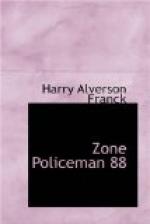On the screened veranda of a somewhat sooty and dismal building high up near the summit of the town, another and I were pacing anxiously back and forth when, well on in the morning, an abrupt and rather gloomy-faced American dashed into the building and one of the rooms thereof, snapping over his shoulder as he disappeared, “One of you!” The other had precedence. Then soon from behind the wooden shutters came a growl of “Next!” and two moments later I was standing in the reputed costume of Adam on the scales within. At about ten-second intervals a monosyllable fell from the lips of the morose American as he delved into my personal make-up from crown to toe with all the instrumental circumspection known to his secret-discovering profession. Then with a gruff “Dress!” he sat down at a table to scratch a few fantastic marks on the blank I had brought, and hand it to me as I caught up my last garment and turned to the door. But, alas—tight sealed! and all the day, though carrying the information in my pocket, I must live in complete ignorance of whether I had been found lacking an eye or a lung. For sooner would one have asked his future of the scowling Parques than venture to invoke a hint thereof from that furrow-browed being from the Land of Bruskness.
Meanwhile, as if it had been thus planned to give me such opportunity, I stood at the very vortex of canal interest and fame, with nearly an entire day before the evening train should carry me back to Corozal. I descended to the “observation platform.” Here at last at my very feet was the famous “cut” known to the world by the name of Culebra; a mighty channel a furlong wide plunging sheer through “Snake Mountain,” that rocky range of scrub-wooded hills; severing the continental divide. At first view the scene was bewildering. Only gradually did the eye gather details out of the mass. Before and beyond were pounding rock drills, belching locomotives, there arose the rattle and bump of long trains of flat-cars on many tracks, the crash of falling boulders, the snort of the straining steam-shovels heaping the cars high with earth and rock, everywhere were groups of little men, some working leisurely, some scrambling down into the rocky bed of the canal or dodging the clanging trains, all far below and stretching endless in either direction, while over all the scene hovered a veritable Pittsburg of smoke.
All long-heralded sights—such is the nature of the world and man —are at first glimpse disappointing. To this rule the great Culebra “cut” was no exception. After all this was merely a hill, a moderate ridge, this backbone of the Isthmus the sundering of which had sent its echoes to all corners of the earth. The long-fed imagination had led one to picture a towering mountain, a very Andes.




